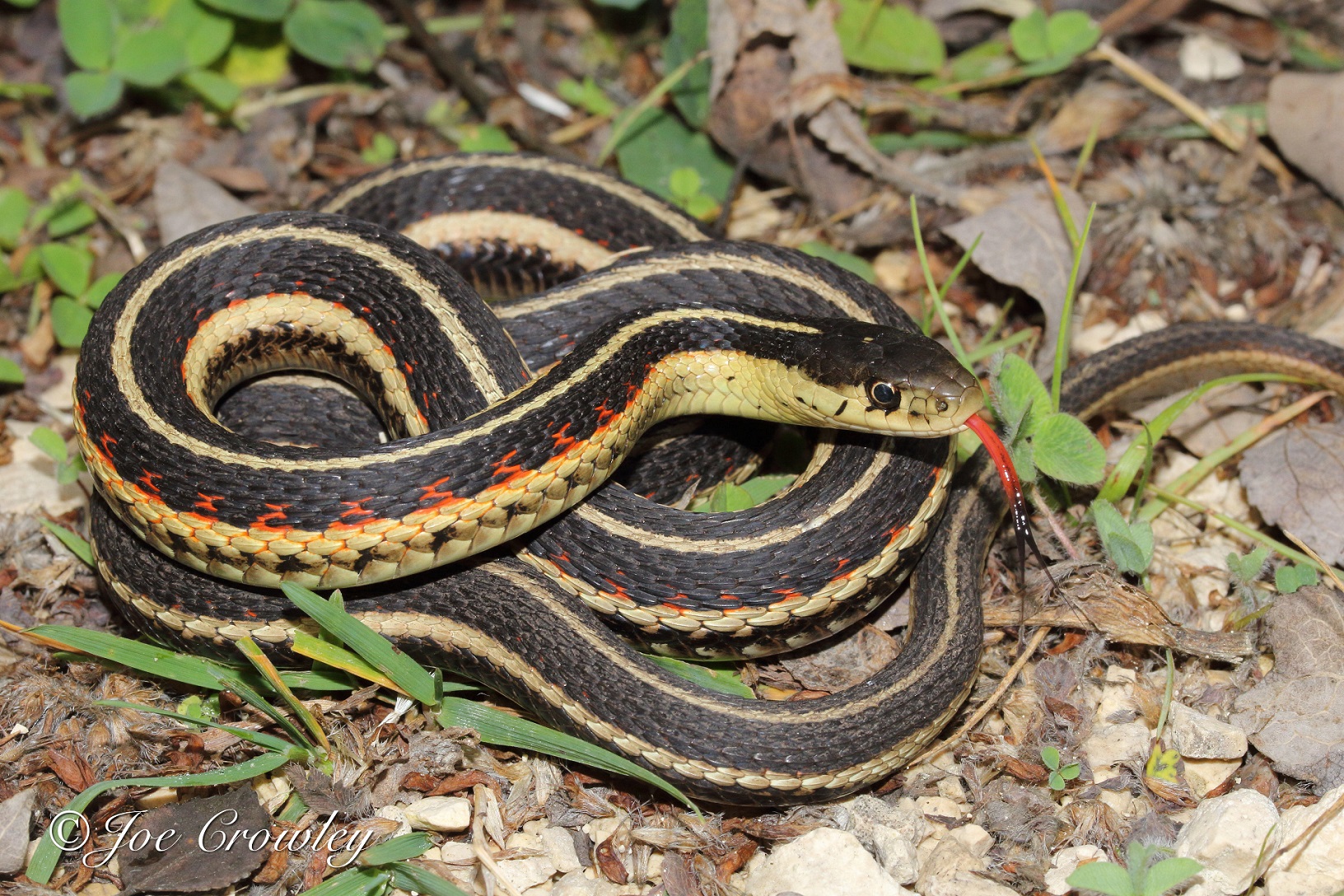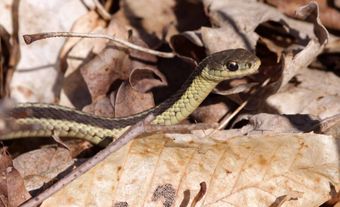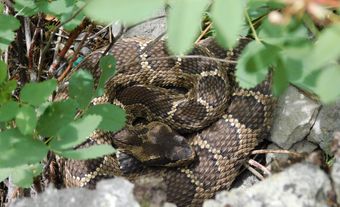
Snake Species in Canada
|
Common Name |
Scientific Name |
Subspecies |
Provinces/Territories |
|
Butler's gartersnake |
Thamnophis butleri |
ON |
|
|
Thamnophis sirtalis |
- Maritime gartersnake (Thamnophis sirtalis pallidulus) - Eastern gartersnake (Thamnophis sirtalis sirtalis) - Red-sided gartersnake (Thamnophis ssirtalis parietalis) - Valley gartersnake (Thamnophis sirtalis fitchi) - Puget Sound gartersnake (Thamnophis sirtalis pickeringii) |
NWT, BC, AB, SK, MB, ON, QC, NB, NS, PEI, NL |
|
|
Common sharp-tailed snake |
Contia tenuis |
BC |
|
|
Nerodia sipedon |
- Lake Erie watersnake (Nerodia sipedon insularum) - Northern watersnake (Nerodia sipedon sipedon) |
ON, QC |
|
|
Dekay's brownsnake |
Storeria dekayi |
ON, QC |
|
|
Desert nightsnake |
Hypsiglena chlorophaea |
BC |
|
|
Pantherophis vulpinus |
ON |
||
|
Heterodon platirhinos |
ON |
||
|
Sistrurus catenatus |
ON |
||
|
Eastern milksnake |
Lampropeltis triangulum |
ON, QC |
|
|
Eastern ribbonsnake |
Thamnophis saurita |
ON, QC, NS |
|
|
Gophersnake |
Pituophis catenifer |
- Great basin gophersnake (Pituphis catenifer deserticola) - Bullsnake (Pituphis catenifer sayi) |
BC, AB, SK |
|
Pantherophis spiloides |
ON |
||
|
Coluber constrictor |
- Western yellow-bellied racer (Coluber constrictor mormon) - Blue racer (Coluber constrictor foxii) - Eastern yellow-bellied racer (Coluber constrictor flaviventris) |
BC, AB, SK, ON |
|
|
Northern rubber boa |
Charina bottae |
BC |
|
|
Northwestern gartersnake |
Thamnophis ordinoides |
BC |
|
|
Plains gartersnake |
Thamnophis radix |
AB, SK, MB |
|
|
Plains hog-nosed snake |
Heterodon nasicus |
AB, SK, MB |
|
|
Crotalus viridis |
AB, SK |
||
|
Regina septemvittata |
ON |
||
|
Red-bellied snake |
Storeria occipitomaculata |
SK, MB, ON, QC, NB, NS, PEI |
|
|
Ring-necked snake |
Diadophis punctatus edwardsi |
ON, QC, NB, NS, PEI |
|
|
Smooth green snake |
Opheodrys vernalis |
SK, MB, ON, QC, NB, NS, PEI |
|
|
Terrestrial gartersnake |
Thamnophis elegans |
Wandering gartersnake (Thamnophis elegans vagrans) |
BC, AB, SK |
|
Crotalus oreganus |
BC |
Description
Snakes are limbless. However, primitive forms, such as the Northern rubber boa, have a pelvic girdle and spurs. Spurs are small, bony projections that are the remnants of hind limbs. As with other reptiles, a snake’s body is covered with scales, which help reduce water loss in dry environments and provide protection. Snakes do not have eyelids. Instead, they have a clear scale that covers each eye. They also do not have external ear openings and, therefore, have poor hearing. Snakes primarily rely on smell to navigate their environment, including to find mates, to hunt for prey and to locate familiar habitats. Scent molecules are picked up by the forked tongue, which is continually flicked in and out of the mouth. The molecules on each side of the tongue are delivered to vomeronasal (or Jacobson’s) organs in the roof of the mouth. The relative concentration of scent molecules on either side of the forked tongue allows snakes to assess the direction of smells with high precision. Snakes shed their skin, usually as a single piece, a few times a year.
Habitat
Snakes live in a wide variety of habitats, including terrestrial environments, underground burrows, trees, and fresh and salt water. Most Canadian snakes are ground dwellers, but some are semi-aquatic and others semi-arboreal (meaning they climb trees). In Canada where the weather is comparatively cool, snakes are typically found in areas with open canopies where they can bask in the sun to maintain optimal body temperatures. These habitats include forest clearings and edges, fields, wetlands, the shorelines of lakes or rivers, rock outcrops, and mountain slopes. During cold Canadian winters, snakes hibernate underground in rock crevices, mammal burrows, ant mounds, root hollows or other habitats where they can get below the frost line.
Did you know?
Prior to 2010, there had been no evidence of snakes in Newfoundland. Since then, however, common gartersnakes seem to have made their way onto the western coast of Newfoundland, likely via anthropogenic means. Pregnant individuals and juveniles have also been found, suggesting common gartersnakes may be breeding on the island.
Locomotion
Although limbless, snakes can move in various ways. In the most common method, lateral undulation, the body is formed into a series of horizontal curves and the back of each curve is pressed against irregularities in the ground to push the snake forward. A similar technique is used in swimming. Heavy-bodied snakes (e.g., rattlesnakes) can also exhibit rectilinear (straight line) locomotion. In rectilinear locomotion propulsion occurs by the forward movement of the skin and the anchoring of the wide, posteriorly oriented ventral scales, followed by forward movement of the body within. Concertina movement is used by some species in confined spaces. In concertina movement the snake anchors its back end in a few horizontal curves, extends and re-anchors its front end, then brings the back end forward. The most specialized form of locomotion, sidewinding, is used on soft (and hot) surfaces such as desert sands. Sidewinding is not practised regularly by any Canadian species.
Diet
All snakes are carnivores and eat their prey whole. Boids, viperids and larger colubrids feed mainly on warm-blooded prey such as small mammals. Other species of colubrids feed on a wide variety of animals, including small mammals, amphibians and fish; some, especially smaller species, eat small invertebrates such as earthworms, slugs and insects.
The elastic ligament joining a snake’s two lower jaw bones and the numerous joints between the bones of the skull allow the various parts of skull and lower jaws to move independently. This means a snake can swallow prey that is much larger than its head. While back-curved teeth hold prey, snakes “walk” the jaw over their food when swallowing. Elastic skin and a windpipe opening in the mouth are also adaptations that facilitate the often lengthy process of swallowing large food whole.

Predation
Most species of snake detect prey visually and chemically. Pit vipers (e.g., rattlesnakes) feed mainly on warm-blooded animals and can accurately locate prey even in darkness via the thermosensory pit below the eye. Many boas and pythons have thermosensory organs along the upper or lower jaw. Although snakes can detect earthborn vibrations and low-frequency sound, their hearing is poorly developed.
Many species simply grab prey and swallow it live, usually head first. However, with some prey, the risk of injury is relatively high. More specialized modes involve killing before eating. Constrictors coil around prey, preventing it from breathing or causing it heart failure. Although boas and pythons are the most famous constrictors, constriction is practised by many other species, including gophersnakes and ratsnakes in Canada.
The most effective and least risky means of subduing prey is by envenomation. Venomous snakes have a venom gland above the upper jaw, connected by a duct to the fangs in the mouth. The venom kills the prey and begins its digestion while the snake waits for it to die. Vipers have long, hollow fangs at the front of the mouth that are hinged, which allows them to fold back along the roof of the mouth when not in use. The four rattlesnake species that are native to Canada are pit vipers, which are a subfamily of vipers (one, the timber rattlesnake, is extirpated). Snakes in the family Elapidae (e.g., cobras in Africa and Asia, and coral snakes in North America) have shorter, permanently erect, hollow fangs at the front of their mouth. These species are not found in Canada. Some snakes in the family Colubridae are also venomous, usually mildly so; they have grooved teeth at the rear of the jaw and “chew” venom into prey. Canadian rear-fanged snakes include the desert night snake and hog-nosed snakes, among others, all of which are harmless to humans.
Body Temperature
Like other reptiles, snakes are ectotherms. Ectotherms do not generate their own body heat; their body temperature is governed by external conditions. They can regulate their body temperature through behaviour and habitat use, for example, by moving in and out of shade. While northern snakes are generally more cold-tolerant than tropical species, winter temperatures in northern temperate regions are too cold for continued activity or survival. Snakes in Canada must therefore hibernate below the frost line.
In areas with very cold winters, sites that allow snakes to go deep enough to avoid subfreezing temperatures may be scarce, and available sites are used by many snakes. Communal hibernation is demonstrated particularly well in Western Canada by the Western rattlesnake and the common gartersnake; hibernating groups of the latter may number in the thousands. Because overwintering sites are often concentrated in particular areas, communal hibernation is sometimes accompanied by migrations of several kilometres between the hibernation site and summer habitat.
Reproduction
In Canada, most snake species mate in spring shortly after hibernation or in the late summer or fall. When mating occurs in the late summer or fall, the female retains sperm over winter and fertilization occurs the following spring. Fertilization in snakes is internal and sperm are transferred into the female by a copulatory organ. Each male has two such organs (hemipenes) housed in the base of the tail. Some species of snakes lay eggs while others give birth to live young. While egg-laying species are more numerous worldwide, the proportion of live-bearing species is higher in cooler environments. For example, 15 of the snake species native to Canada are live-bearers. Live bearing is a useful adaptation where summers are short because the female can better regulate the temperature at which the young develop compared to laying eggs in a specific location. Females give birth in the late summer and may be unable to feed enough before hibernation to reproduce again the following summer. Consequently, female snakes at high latitudes may only produce a brood every two or more years.

 Share on Facebook
Share on Facebook Share on X
Share on X Share by Email
Share by Email Share on Google Classroom
Share on Google Classroom




